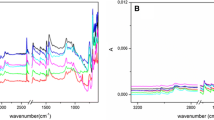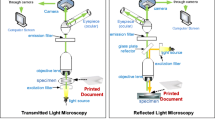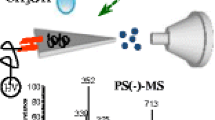Abstract
The detection of computer-generated document forgeries has always been a challenging task for forensic document examiners (FDE). With the aim to support the examination processes, Schottky field emission scanning electron microscopy with energy-dispersive X-ray spectroscopy (FE-SEM-EDS) is explored as a recent tool to analyze black toners obtained from laser printers and photocopier machines. Forty samples each from the laser printer and photocopier machines are procured and studied for morphological features, elemental profile, and multivariate analysis. The acquired SEM images and spectra are evaluated to discriminate and classify the toners having a different source of origin. Multivariate analysis is applied to develop a model of classification to successfully classify the printed documents on the basis of the similarities and differences in their composition. Hierarchical cluster analysis (HCA) discriminates the printouts in the forms of groups based on their chemical composition. The laser printer and the photocopier printed documents are grouped into 11 and eight clusters, respectively, based on their elemental composition. Cross-validation is further conducted to assess the capabilities of developed principal component analysis (PCA) and linear discriminant analysis (LDA) models for the examination of printouts from unknown origin.

Graphical abstract






Similar content being viewed by others
References
Kelly JS, Lindblom BS. Scientific examination of questioned documents. 2nd ed. New York: Taylor Francis; 2006.
Marshall G. Recent progress in toner technology. Soc Imaging Sci Technol; 1997.
Scharfe M. Electrophotography and optimization. Letchworth, Hertfordshire, England: Research Studies Press Ltd. New York: John Wiley & Sons INC; 1984.
James EL. The classification of office copy machines from physical characteristics. J Forensic Sci. 1987;32:1293–304.
Totty R. The examination of photocopy documents. Forensic Sci Int. 1999;46:121–6.
Kipphan H. Handbook of print media: technologies and production method: Springer; 2001.
Schien LB. Recent advances in our understanding of toner charging. J Electrost. 1999;46:29–36.
Leach R. The printing ink manual. 4th ed. Berlin: Springer Verlag Gmbh; 1988.
Park J, Ahn S, Yoo J, Kim D, Kim DS. Effects of polymerization process variables on the properties of suspension polymerized toner. In: 18th International Conference on Composite Materials, Edinburgh, Scotland; 2009.
Yang J, Wang TJ, He H, Wei F, Jin Y. Particle size distribution and morphology of in situ suspension polymerized toner. Ind Eng Chem Res. 2003;42:5568–75.
Lennard C, Mazzella W. A simple combined technique for the analysis of toners and adhesives. J Forensic Sci Soc. 1991;31(3):365–71.
Meng P, Wang S. Identification of copy machines through pyrolysis chromatography of toners. Int J Doc Exam. 1995;5:88–90.
Verma N, Kumar R, Sharma V. Analysis of laser printer and photocopier toners by spectral properties and chemometrics. Spectrochim Acta A Mol Biomol Spectrosc. 2018;196:40–8.
Merrill RA, Bartick EG, Taylor JH. Forensic discrimination of photocopy and printer toners, part II. Anal Bioanal Chem. 2003;376:1279–85.
Materazzi S, Risoluti R, Pincia S, Romolob FS. New insights in forensic chemistry: NIR/chemometrics analysis of toners for questioned documents examination. Talanta. 2017;174:673–8.
Udristioiu EG, Bunaciu AA, Aboul-Enein HY, Tanase I. Infrared spectrometry in discriminant analysis of laser printer and photocopy toner on questioned documents. Instrum Sci Technol. 2009;37:230–40.
Trzcinska BM, Brozek-Mucha Z. The possibilities of identifying photocopy toners by means of infrared spectroscopy (FTIR) and scanning microscopy. Mikrochim Acta. 1997;14:235–7.
Trzcinska BM. Classification of black powder toners on the basis of integrated analytical information provided by Fourier transform infrared spectrometry and X-ray fluorescence spectrometry. J Forensic Sci. 2006;51:919–24.
Egan WJ, Morgan SL, Bartick EG, Merrill RA, Taylor JH III. Forensic discrimination of photocopy and printer toners. II. Discriminant analysis applied to infrared reflection–absorption spectroscopy. Anal Bioanal Chem. 2003;376:1279–85.
Trzcinska BM. Discriminating among powder toners of the same colour by the use of spectroscopic methods. Probl Forensic Sci 2015;80–95.
Johnson C, Martin P, Roberts K, Trejos T, Corzo R, Almirall J, et al. The capability of Raman micro spectroscopy to differentiate printing inks. J Forensic Sci. 2017:1–14.
Chu PC, Cai BY, Tsoi YK, Yuen R, Leung SK, Cheung NH. Forensic analysis of laser printed ink by X-ray fluorescence and laser-excited plume fluorescence. Anal Chem. 2013;85:4311–5.
Williamson R, Raeva A, Almirall J. Characterization of printing inks using DART-Q-TOF-MS and attenuated total reflectance (ATR) FTIR. J Forensic Sci. 2016;61:706–14.
Trejos T, Torrione P, Corzo R, Raeva A, Subedi K, Williamson R, et al. A novel forensic tool for the characterization and comparison of printing ink evidence: development and evaluation of a searchable database using data fusion of spectrochemical methods. J Forensic Sci. 2016;61:716–24.
Egan WJ, Galipo RC, Kochanowski BK, Morgan SL, Bartick EG, Miller ML, et al. Forensic discrimination of photocopy and printer toners. III. Multivariate statistics applied to scanning electron microscopy and pyrolysis gas chromatography-mass spectrometry. Anal Bioanal Chem. 2003;376:1286–97.
Gilmour CL. A comparison of laser printed and photocopied documents can they be distinguished? J Can Soc Forensic Sci. 1997;27:245–59.
Brandi J, James B, Gutowski SJ. Differentiation and classification of photocopier toners. Int J Forensic Doc Exam. 1997;3:324–44.
Trejos T, Corzo R, Subedi K, Almirall J. Characterization of toners and inkjets by laser ablation spectrochemical methods and scanning electron microscopy-energy dispersive X-ray spectroscopy. Spectrochimica Acta B. 2014;92:9–22.
Corzo R, Subedi K, Trejos T, Almirall J. Evaluation of the forensic utility of scanning electron microscopy-energy dispersive spectroscopy and laser ablation-inductively coupled plasma-mass spectrometry for printing ink examinations. J Forensic Sci. 2016;61:725–34.
Szynkowska MI, Czerski K, Paryjczaka T, Parczewskib A. Ablative analysis of black and colored toners using LA-ICP-TOF-MS for the forensic discrimination of photocopy and printer toners. Surf Interface Anal. 2010;42:429–37.
Almirall J, Trejos T. Applications of LAICPMS to forensic science. Elements. 2016;12:335–40.
Subedi K, Trejos T, Almirall J. Forensic analysis of printing inks using tandem LIBS and LAICP-MS. Spectrochim Acta B At Spectrosc. 2015;103:76–83.
Lennard C, Deftar M, Robertson J. Forensic application of laser-induced breakdown spectroscopy for the discrimination of questioned documents. Forensic Sci Int. 2015;254:68–79.
Metzinger A, Rajko R, Galbacs G. Discrimination of paper and print types based on their laser induced breakdown spectra. Spectrochim Acta B. 2014;94–95:48–57.
Kumar R, Sharma V. Chemometrics in forensic science. TrAC Trends Anal Chem. 2018;105:191–201.
Massart DL, Vandeginste BGM, Deming SN, Michotte Y, Kaufmann L. Chemometrics textbook. In: Elsevier; Amsterdam; 1988.
Møller SF, von Frese J, Bro R. Robust methods for multivariate data analysis. J Chemom. 2005;19:549–63.
Brereton RG. Chemometrics: data analysis for the laboratory and chemical plant. Chichester: Wiley; 2003.
McLachlan G. Discriminant analysis and statistChichesterical pattern recognition: Wiley; 2004.
Sharma V, Kumar R. Trends of chemometrics in bloodstain investigations. TrAC Trends Anal Chem. 2018;107:181–95.
Huberty CJ, Olejnik S. Applied MANOVA and discriminant analysis. 2nd ed. Chichester: Wiley; 2007.
Smalldon KW, Moffat AC. The calculation of discrimination power for a series of correlated attributes. J Forensic Sci Soc. 1973;13:291–5.
Kursula PK. Accuracy, precision and detection limits of SEM-WDS, SEM-EDS and PIXE in the multi elemental analysis of medieval glass. X-Ray Spectrom. 2000;29:111–8.
Gruber RJ, Julien PC, Toner Technology D. Handbook of imaging materials. 2nd ed. New York: Marcel Dekker; 1991.
Ataeefard M, Ghasemi E, Ebadi M. Effect of micro and nano magnetite on printing toner properties. Sci World J. 2014;7:706367.
Birkett KL, Gregory P. Metal complex dyes as charge control agents. Dyes Pigments. 1986;7:341–50.
Hartus T. Adhesion of electrophotographic toner on paper. Graphic Arts Finland 2001;30:3.
Nienow AW, Ding P, Pacek AW, Abinhava K, Pickard S, Edwards MR. A process for the manufacture of chemically produced toner (CPT). II. Effect of operating conditions. Ind Eng Chem Res. 2005;44:6012–21.
Ataeefard M. Production of carbon black acrylic composite as an electrophotographic toner using emulsion aggregation method: investigation the effect of agitation rate. Compos Part B. 2014;64:78–83.
Kim TK. T test as a parametric statistic. Korean J Anesthesiol. 2015;68:540–6.
Sharma V, Bharti A, Kumar R. On the spectroscopic investigation of lipstick stains: forensic trace evidence. Spectrochim Acta A Mol Biomol Spectrosc. 2019;215:48–57.
Anandarajan M, Hill C, Nolan T. Cluster analysis: modeling groups in text. In: Practical text analytics, advances in analytics and data science, vol. 2. Cham: Springer; 2019.
Kaiser HF. An index of factorial simplicity. Psychometrika. 1974;39:31–6.
Hair JF, Black WC, Babin BJ, Anderson RE, Tatham RL. Multivariate data analysis. Upper Saddle River: Pearson Prentice Hall; 2006.
Hair JF, Black WC, Babin BJ, Anderson RE. Multivariate data analysis. 7th ed. Upper Saddle River: Prentice Hall; 2010.
Acknowledgments
The author Neha Verma is very grateful to the DFSS for awarding JRF fellowship (Letter No. Adm-3209).
Funding
This study received grants from the Department of Science and Technology (DST) (Govt. of India) through sanction no. EMR/2016/001103 (SERB) and PURSE-II grant.
Author information
Authors and Affiliations
Corresponding author
Ethics declarations
Conflict of interest
The authors declare that there is no conflict of interest.
Additional information
Publisher’s note
Springer Nature remains neutral with regard to jurisdictional claims in published maps and institutional affiliations.
Electronic supplementary material
ESM 1
(PDF 2.46 mb)
Rights and permissions
About this article
Cite this article
Verma, N., Sharma, V., Kumar, R. et al. On the spectroscopic examination of printed documents by using a field emission scanning electron microscope with energy-dispersive X-ray spectroscopy (FE-SEM-EDS) and chemometric methods: application in forensic science. Anal Bioanal Chem 411, 3477–3495 (2019). https://doi.org/10.1007/s00216-019-01824-z
Received:
Revised:
Accepted:
Published:
Issue Date:
DOI: https://doi.org/10.1007/s00216-019-01824-z




